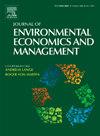Informing the uninformed, sensitizing the informed: The two sides of consumer environmental awareness
IF 5.9
3区 经济学
Q1 BUSINESS
Journal of Environmental Economics and Management
Pub Date : 2025-08-28
DOI:10.1016/j.jeem.2025.103226
引用次数: 0
Abstract
How do environmental information and awareness interact to improve environmental quality by changing consumer behavior and firm strategies? This article provides theoretical insights using an original differentiation model within a general framework whose specific cases have been studied previously. On the demand side, only informed consumers differentiate brown from green product quality, while uninformed consumers consider these perfect substitutes. Moreover, all informed consumers value the green product and devalue the brown product due to an aversion effect but are heterogeneous in their environmental awareness. On the supply side, two firms offer different environmental qualities and compete on price. We consider two types of environmental campaigns: increasing the number of informed consumers and increasing the environmental awareness of informed consumers. We show that these campaigns crucially determine three market configurations: segmented; fragmented, with a brown product that appeals to both uninformed consumers and a fraction of informed consumers; and covered. Assuming that the greenest consumer behavior is abstention, we find that a situation where all consumers are informed and some are highly environmentally aware is not necessarily the greenest. Depending on the aversion effect, the campaign organizer’s budget, and their relative cost-effectiveness, information and awareness-raising campaigns require a judicious mix.
告知不知情的人,使知情的人敏感:消费者环境意识的两个方面
环境信息和意识如何通过改变消费者行为和企业战略来相互作用以改善环境质量?本文使用一个原始的分化模型在一个一般框架内提供了理论见解,其具体案例已被研究过。在需求侧,只有知情的消费者才会区分棕色和绿色的产品质量,而不知情的消费者则会认为这些是完美的替代品。此外,所有知情的消费者都因厌恶效应而重视绿色产品并贬低棕色产品,但他们的环境意识是异质性的。在供给方面,两家公司提供不同的环境质量,并在价格上竞争。我们考虑了两种类型的环保运动:增加知情消费者的数量和提高知情消费者的环保意识。我们发现,这些营销活动至关重要地决定了三种市场配置:细分市场;碎片化,棕色产品既能吸引不知情的消费者,也能吸引一小部分知情的消费者;和覆盖。假设最环保的消费者行为是弃权,我们发现,所有消费者都知情且一些消费者具有高度环保意识的情况不一定是最环保的。根据厌恶效应、活动组织者的预算和他们的相对成本效益,信息和提高意识的活动需要一个明智的组合。
本文章由计算机程序翻译,如有差异,请以英文原文为准。
求助全文
约1分钟内获得全文
求助全文
来源期刊
CiteScore
8.00
自引率
4.30%
发文量
91
期刊介绍:
The Journal of Environmental Economics and Management publishes theoretical and empirical papers devoted to specific natural resources and environmental issues. For consideration, papers should (1) contain a substantial element embodying the linkage between economic systems and environmental and natural resources systems or (2) be of substantial importance in understanding the management and/or social control of the economy in its relations with the natural environment. Although the general orientation of the journal is toward economics, interdisciplinary papers by researchers in other fields of interest to resource and environmental economists will be welcomed.

 求助内容:
求助内容: 应助结果提醒方式:
应助结果提醒方式:


